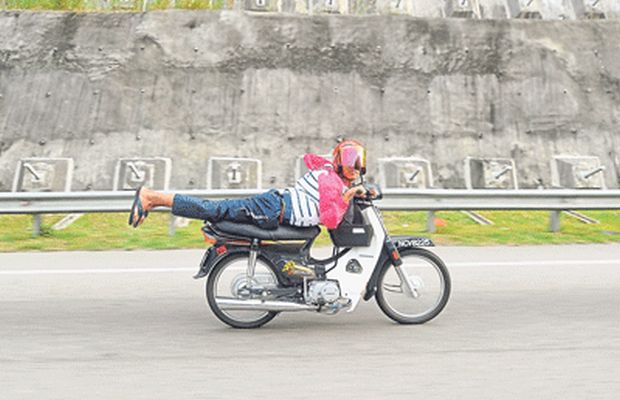KUALA LUMPUR, Feb 25 — Allowing the mat rempit to race on designated roads in the city is not a comprehensive solution to the illegal racing nuisance that the public have been putting up with for so many years, according to experts.
It might only serve as a short gap measure to provide the youths concerned with an avenue to let off some steam, said crime analyst Datuk Akhbar Satar, adding that more concrete solutions would be needed to contain the unhealthy activity.
Akhbar, who is also Transparency International-Malaysia president, said the proposal - made by Federal Territories Minister Datuk Seri Tengku Adnan Tengku Mansor - seemed ineffective to him as it could not possibly yield any long-term benefits.
On Monday, Tengku Adnan said talks were underway to allow the mat rempit to race legally on certain streets in the city by closing the roads to traffic.
While the proposal received the thumbs down from various sections of the public, Kuala Lumpur City Hall Mayor Mohd Amin Nordin Abd Aziz said he was open to the idea and even suggested that the bridge connecting Taman Metropolitan Batu and Kampung Batu Muda be used for the races.
Inspector-General Tan Sri Khalid Abu Bakar said he would meet Tengku Adnan to get more information on his plan.
Akhbar said allowing the mat rempit to race in the city for a few hours would only enable them to “get a temporary kick out of racing and it won’t do much to take away their overwhelming desire” to indulge in racing.
“I don’t support (Tengku Adnan’s proposal) as I don’t see any long-term benefits... by right, the government should look for more effective and ingenious ways to address the problem,” he told Bernama.
Psychological issues
Akhbar felt that education could be a good tool to stem the growth of the unhealthy racing culture, adding that all positive and negative habits or inclinations have their beginnings at home and in the school.
“Children should be taught good values and encouraged to take up healthy pursuits,” he said, adding that it was also unfair to label all mat rempit as street hooligans or snatch thieves.
“When we give them such a label, it seems as if we’re encouraging them,” he added.
Psychiatrist Dr Muhammad Muhsin Ahmad Zahari also agreed that good upbringing played an important role in curtailing bad habits.
Pointing to parents in rural and suburban areas who allow their teenage children to ride motorcycles, he said they should be blamed if their children went astray.
“They’re not concerned about their children’s safety as most of them don’t wear helmets. Some parents are so busy that they don’t even realise that their children are out late at night racing on the streets and performing all kinds of stunts on their bikes,” said Muhammad Muhsin, who is also a senior lecturer at Universiti Malaya’s Department of Psychological Medicine.
He said schools should also provide an avenue for students to express their grievances if they had any.
“Their desire to indulge in illegal racing may be caused by psychological issues... probably, they have some deep-rooted problems, so they do whatever they can to divert their attention from those problems. They view illegal racing as a chance to socialise and chill out,” he said.
Special circuit
Instead of closing certain roads in the city to make way for the mat rempit to race, the government should consider building special circuits for them, said Muhammad Muhsin, adding that it would help curtail illegal racing and, at the same, inspire the youths to develop a love for motorsports.
“Those interested in racing should be allocated proper circuits... allowing them to race in public places is risky as it not only endangers their own lives but that of others as well.
“By giving them their own racing track, they are less likely to participate in illegal races and they can show off their riding skills on these circuits,” he said.
He added that it would be pointless, however, if such circuits imposed steep rates as it would deter youths from using them and they would continue to resort to racing on the streets.
Repenter’s story
A former mat rempit, who only wanted to be identified as Irham, meanwhile, said youths may initially respond to Tengku Adnan’s proposal but the novelty of regulated racing may wear off soon as they preferred the thrill of participating in no-holds-barred street races.
“Mat rempit want to experience the city atmosphere, they want public attention... but if the roads are closed (for them to race), it won’t be the same. For them, closed roads are not thrilling enough.
“Once they get fed up with the ‘legal’ racing, they will return to their old haunts,” said Irham, 37, who is now an assistant engineer.
He said he quit illegal racing after some of his friends were killed in road accidents, which he personally witnessed.
One died after he crashed into a cow, while two others were killed when they collided with each other while racing.
“Although I’ve never been involved in accidents or detained by the police, I decided to give it up some 15 years ago.
“I used to be an active mat rempit during the 1990s up to early 2000. Come weekends, you will see me on my bike zipping from my hometown in Rembau to Kuala Lumpur or Melaka. Anyway, it was cheaper to be a mat rempit than take part in car racing or go to discos,” said Irham, who used to ride his own motorcycle to school.
“I started riding when I was in Form Three. In Form Five, I used my brother’s Yamaha RXZ bike... in my kampung there was nothing much for me to do except toy around with the motorcycle,” he said. — Bernama




















